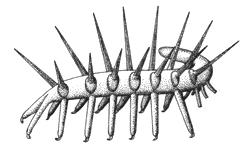BIOLOGY
by Miller & Levine
[complete Table of Contents]

|
Use the pull-down menu to jump to any of the Book's 40 Chapters: |
Additional Resources:

Wondering
what this critter is (was)? Click Here to find out
![]() Chapter 29
Chapter 29 ![]()
Comparing Invertebrates
In this chapter, students will read about the major trends and patterns in the evolution of invertebrate animals. They will also read about the major organ systems and life functions of invertebrates. The links below lead to additional resources to help you with this chapter. These include Hot Links to Web sites related to the topics in this chapter, the Take It to the Net activities referred to in your textbook, a Self-Test you can use to test your knowledge of this chapter, and Teaching Links that instructors may find useful for their students.
| Hot Links | Chapter Self-Test |
| Take it to the Net | Teaching Links |
What are Web Codes? |
Web
Codes for Chapter 29: |
![]()
Section
29-1: Invertebrate Evolution
![]() As animals became
larger and more complex, specialized cells joined together to form tissues,
organs, and organ systems that work together to carry out complex functions.
As animals became
larger and more complex, specialized cells joined together to form tissues,
organs, and organ systems that work together to carry out complex functions.
![]() All invertebrates
except sponges exhibit some type of body symmetry—either radial symmetry
or bilateral symmetry.
All invertebrates
except sponges exhibit some type of body symmetry—either radial symmetry
or bilateral symmetry.
![]() Invertebrates
with cephalization can respond to the environment more quickly and in
more sophisticated ways than can simpler invertebrates.
Invertebrates
with cephalization can respond to the environment more quickly and in
more sophisticated ways than can simpler invertebrates.
![]() Most invertebrates
with bilateral symmetry also have segmented bodies. Over the course of
evolution, different segments have often become specialized for specific
functions.
Most invertebrates
with bilateral symmetry also have segmented bodies. Over the course of
evolution, different segments have often become specialized for specific
functions.
![]() Most animal phyla
have a true coelom that is lined completely with mesoderm.
Most animal phyla
have a true coelom that is lined completely with mesoderm.
![]() Worms, arthropods,
and mollusks are protostomes, and echinoderms are deuterostomes.
Worms, arthropods,
and mollusks are protostomes, and echinoderms are deuterostomes.
Section
29-2: Form and Function in Invertebrates
![]() The simplest animals
break down food primarily through intracellular digestion, whereas more
complex animals use extracellular digestion.
The simplest animals
break down food primarily through intracellular digestion, whereas more
complex animals use extracellular digestion.
![]() Respiratory organs
have large surface areas that are in contact with the air or water. In
order for diffusion to occur, these respiratory surfaces must be kept
moist.
Respiratory organs
have large surface areas that are in contact with the air or water. In
order for diffusion to occur, these respiratory surfaces must be kept
moist.
![]() Most complex animals
move fluid through their bodies using one or more hearts and an open or
closed circulatory system.
Most complex animals
move fluid through their bodies using one or more hearts and an open or
closed circulatory system.
![]() Most animals have
an excretory system that rids the body of metabolic wastes and controls
the amount of water in their tissues.
Most animals have
an excretory system that rids the body of metabolic wastes and controls
the amount of water in their tissues.
![]() Invertebrates
show three trends in the evolution of the nervous system: centralization,
cephalization, and specialization.
Invertebrates
show three trends in the evolution of the nervous system: centralization,
cephalization, and specialization.
![]() Invertebrates
have one of three main kinds of skeletal systems: hydrostatic skeletons,
exoskeletons, and endoskeletons.
Invertebrates
have one of three main kinds of skeletal systems: hydrostatic skeletons,
exoskeletons, and endoskeletons.
![]() Most invertebrates
reproduce sexually during at least part of their life cycle. Depending
on environmental conditions, however, many invertebrates may also reproduce
asexually.
Most invertebrates
reproduce sexually during at least part of their life cycle. Depending
on environmental conditions, however, many invertebrates may also reproduce
asexually.